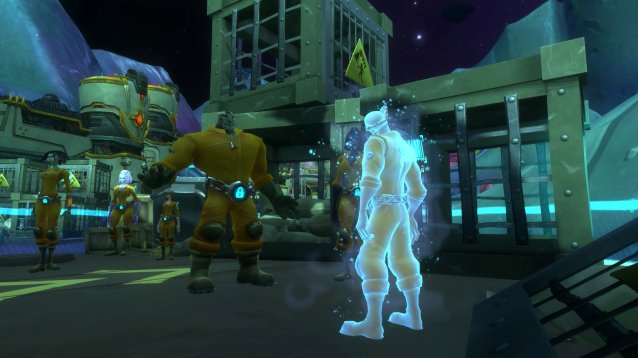

Game Rant’s Ben Kendrick reviews Alan Wake’s American Nightmare
On May 18th 2010, gamers were treated by the release of two critically-acclaimed titles: one (Red Dead Redemption) would go on to sell over 13 million copies, the other (Alan Wake) racked up plenty of rave reviews (read our Alan Wake review) but suffered disappointing sales as a result of Rockstar’s mega-hit Western-themed offering. However, over the last two years word of mouth (as well as budget price-points) have encouraged more and more gamers to journey into the darkness with Alan Wake.
In an effort to draw even more attention to the would-be-franchise, Remedy has released the downloadable spin-off installment, Alan Wake’s American Nightmare, through Xbox Live Arcade. Does the digital-only experience take the best pieces of the original Alan Wake (the atmosphere, story, and familiar literary as well as cinematic allusions) while also refining some of the title’s less successful gameplay mechanics (most notably repetitive combat and limited enemy types)?
Much like its predecessor, Alan Wake’s American Nightmare is a mishmash of enjoyable ideas that are undermined by a few sub-par, and this time flat-out bizarre, design choices. Remedy has been quick to point out that American Nightmare is not a direct sequel – so it’s hard to know whether or not the problematic elements are merely the result of the downloadable title’s limited scope or a larger misconception by the developers regarding what actually worked the first time. Either way, despite its shortcomings, there’s little doubt that fans of the original title – or gamers looking for a quick and fun one-off experience will likely enjoy their time with Wake in Night Springs.
In terms of the over-arching canon plot (one of the major strengths in the series), as mentioned, American Nightmare is presented as a stand-alone story – which, though it has connections to the prior installment (as well as the subsequent DLC chapters), is bookended within the context of a Night Springs TV episode. For anyone not up to speed on Alan Wake, the titular writer got his big break working on a Twilight Zone-like TV series, Night Springs. As a result, American Nightmare doesn’t advance the series storyline much (or at all – depending on how you interpret the ending) and simply offers-up a parallel storyline where, trying to escape the dark presence, Wake is caught in a time loop – forced to relive the same experiences over and over (with only minor adjustments) as he attempts to reshape reality and defeat his evil doppleganger Mr. Scratch. The story is intriguing, especially as the various changes begin to actually affect Wake’s success in each locale, but the narrative definitely falls short of the quality and complexity introduced in the full retail title. This round dialogue is stilted and, with the exception of Wake as well as Mr. Scratch, NPC characters are mostly flat and uninteresting.
The 'Darkness' returns in 'Alan Wake's American Nightmare'
Similarly, while the “time loop” plot line makes for an increasingly engaging story, the resulting gameplay is actually a major step backward for the Alan Wake design team – who were often criticized for the repetitive gameplay in the first title. Instead of funneling the player through a tense but expansive environment (as in the original game), American Nightmare is comprised of three sandbox-like areas, The Rest Stop, The Observatory, and The Drive-In Theater – where, instead of fighting his way through an isolated forest filled with dark enemies, Wake is actually sent on a variety of quests by NPC’s (i.e. find objects scattered around the map or defend a certain point from franchise enemies “The Taken”).
Once all three areas have been cleared of their objectives, Wake revisits the locales again (and again) – each time with minor changes that simplify the fetch quests and other objectives to try and undercut some of the repetition. It’s a slick plot device that allows for Remedy to significantly extend the playtime of the experience without having to actually create nine fresh environments; however, there’s no doubt that, as a result of the repetition (as well as limited georgraphical scope), some gamers will feel cheated.
Two areas where Remedy did improve-upon the overly-recurring elements in the original title are enemy variety and weaponry.
In the original game, defeating enemies nearly always relied on the same strategy: use the light and (depending on the enemy type) then shoot. However, in American Nightmare, there are some enemies that actually act negatively to the light – such as The Splitter (who actually splits in two, then four, then eight, each time it is hit with a focused flashlight beam). Enemy mobility is also improved with the addition of The Spectre – who, instead of lumbering towards Wake, can transform into a flock of birds and quickly flank the writer. While the basic mechanics remain largely the same, and the encounters (even with all the new enemy types) do get repetitive, players will definitely be forced to use a more strategic approach to combat this round.
'The Taken' are now comprised of a diverse batch of enemy types
The weaponry has also been upgraded with the inclusion of a crossbow (which can injure enemies even when they’re still covered in darkness), combat shotgun (which deals out massive damage and offers a relatively quick rate of fire), and an assault rifle (which burns through ammo but easily takes down bigger baddies), among others. Much like the prior title, American Nightmare isn’t the most precise shooter on the market but the combination of light/gunplay is still enjoyable and the new weapons certainly provide players with some fresh options for combat.
The campaign does a solid job of introducing the new weaponry (many of which can only be unlocked by successfully collecting a certain number of the collectable manuscript pages) and enemy types but the additions are especially important for the game’s new “Fight ‘Till Dawn” arcade mode. As we’ve previously mentioned, the new mode adds loads of replay value for gamers who enjoy the core light/shooting mechanics – though, compared to similar “Horde” modes (as in Gears of War 3 or even the upcoming Mass Effect 3), the offering isn’t particularly deep.
Players should expect an experience much more akin to Resident Evil 4 and 5‘s “Mercenaries” mode – where gamers scavenge the environment for supplies and rack up kills and multiplier points (earned by dispatching enemies and successfully evading oncoming attacks) in an allotted amount of time. Ultimately, the offering does add replay value to the package and can be a lot of fun – but, aside from the weapons (which can be unlocked easily in one campaign playthrough), there are no leveling or unlock systems to keep players coming back again and again. That said, especially experienced players can also tackle the various maps on “Nightmare” difficulty – where enemies take more damage and Wake is easier to kill.
'Fight 'Till Dawn' as Alan Wake in the new arcade mode
The addition of “Nightmare” difficulty is only available in the arcade mode – as the campaign has a fixed difficulty level which, for returning Alan Wake players, will probably be a breeze. In general, as a result of the open-world feel, Alan Wake’s American Nightmare is much less challenging and a significantly less-scary experience. It’s unfair to say an easier difficulty and a less spooky atmosphere are negatives – since this is a spin-off experience in an entirely different locale; however, with a campaign length around three hours and very few “scares,” some players may be left feeling underwhelmed by some of the elements they loved in the first game. Gone are the days of scrambling for batteries or frantically rushing up a hill toward an illuminated safe-point while flashing pursuing “Taken” with a beam of focused light – just to buy more time.
Collectible enthusiasts will also find that the manuscript pages are significantly easier to find this round – since they appear on radar when close-by and, for the most part, are littered near objective points. Collecting the scattered pages as well as listening to radio shows and television messages from Mr. Scratch definitely extends the time in-game but not by much, as I spent about five hours in the campaign and found 9/9 radio shows, 9/9 TV shows, and 52/53 manuscript pages.
Ultimately, many of the core Alan Wake design problems return in American Nightmare – leading to a bizarre mishmash of cool ideas that are undermined by extremely repetitive gameplay experiences. However, Alan Wake’s American Nightmare does provide another engaging trip through the mind of the titular writer. Fans who enjoy the combat mechanics and main storyline will likely be satisfied by this downloadable release – which offers plenty of intriguing story ideas plus more monsters, better weaponry, and a likable, albeit forgettable, arcade offering. That said, hopefully Remedy manages to improve upon the core mechanics even further (as well as brings back the tense and scary atmosphere) when the titular writer returns for Alan Wake 2.
–
Follow me on Twitter @benkendrick – and let us know what you thought of the game below.
Alan Wake’s American Nightmare is out now – exclusively on Xbox 360.




 What Far Cry 3 Needs Is An Indoctrination Theory
What Far Cry 3 Needs Is An Indoctrination Theory Killzone 3 Walkthrough
Killzone 3 Walkthrough 13 Fun Mobile Games When You Have NO Data or Wi-Fi
13 Fun Mobile Games When You Have NO Data or Wi-Fi WildStar: Navigating Your First Adventures and Dungeons
WildStar: Navigating Your First Adventures and Dungeons Toxikk (PC) Beginner / Multiplayer Guide
Toxikk (PC) Beginner / Multiplayer Guide